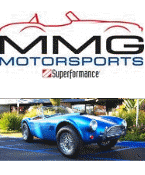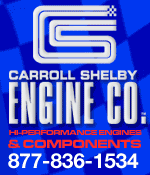 
 Main Menu
Main Menu
|
 Nevada Classics
Nevada Classics
|
 Advertise at CC
Advertise at CC
|
 November 2025
November 2025
|
| S |
M |
T |
W |
T |
F |
S |
| |
|
|
|
|
|
1 |
| 2 |
3 |
4 |
5 |
6 |
7 |
8 |
| 9 |
10 |
11 |
12 |
13 |
14 |
15 |
| 16 |
17 |
18 |
19 |
20 |
21 |
22 |
| 23 |
24 |
25 |
26 |
27 |
28 |
29 |
| 30 |
|
|
|
|
|
|
|
 CC Advertisers
CC Advertisers
|
|

02-09-2004, 10:01 PM
|
 |
CC Member

|
|
|
Join Date: Jun 2003
Location: San Mateo,
CA
Cobra Make, Engine: LA Exotics (B&B) Cobra, 408W, Roush Heads, Demon Carb, Comp Cam, Tremec Z-Spec T5, 9" Auburn Rear
Posts: 185
|
|

 Not Ranked
Not Ranked
 What ELSE can I learn on a dyno?
What ELSE can I learn on a dyno?
I bought my Cobra with the engine in tact, and I know very little about it. It runs very strong and very well, and I do not want to mess with it too much. However, my curiosity is getting the better of me, since I built my last engine from scratch. What can I really learn about the engine w/out disassembling it? I figure hp/torque can be learned on a dyno. Can I determine the displacement? It's a 289, but how can tell if it has it been bored? How about cam duration/lift? Can my shop measure this by popping off a valve cover and measuring valve travel? Finally, can I damage my motor at all by running it at the limit on a dyno to get power numbers? Thanks for all of your help in advance!
|

02-14-2004, 05:47 PM
|
|
Club Cobra Member

|
|
|
Join Date: Feb 2003
Location: SF East Bay,
Ca
Cobra Make, Engine: SPF
Posts: 499
|
|

 Not Ranked
Not Ranked
 Lots of info to be had from the dyno.
Lots of info to be had from the dyno.
Hmm, so many questions but let's have a go.
I can't think of a way to measure displacement without pulling a head off. You need to know the bore and stroke, maybe someone has a way to do this with the head on but I have not heard of it. Cam specs could conceivably be measured like that but my guess is that it would not be super accurate. The dyno can tell you lots of things. Not only how much hp/tq but where it comes in, are the curves flat or linear increase and lots of other stuff you couldn't imagine. A good dyno/tuner can really set up a car. As for damage, it's no more possible than any other spirited driving you might do but I will leave you with this one piece of advice. Don't be there when they do it. You don't want to be around when they wind out your baby to full song. It will make you cringe. 
__________________
We have enough youth. What we need is a fountain of common sense
|

02-14-2004, 06:21 PM
|
|
Senior Club Cobra Member

|
|
|
Join Date: Jan 2001
Location: Bloomfield Hills, (Detroit area),
Mi
Cobra Make, Engine: Superformance 156, ex Paxton 351, now a 392 Ford Racing Stroker
Posts: 1,666
|
|

 Not Ranked
Not Ranked

bore etc, ya gotta pull the heads and measure.
for increased or improved performance , timing/ air fuel ratio etc a chassis dyno is the way to go. however, forget the numbers that get printed out re hp and torque at rear wheels as they are only a barometer to what engine crank dyno's might be. the numbers will vary from dyno to dyno.
however, to ensure proper timing and jetting, the chassis dyno will tell you if you are at optimum settings as well as rear wheel hp and torque. jets, timing etc can be adjusted and changed and the subsequent dyno pulls and air/fuel ratios will tell you if the changes were better or worse. then set it up to the optimum settings. you can readily tell if the changes were +/- from where you started.
you can estimate crank hp /torque from the rw numbers usually allowing for a 17-21% parasitic loss from drivetrain/ exhaust etc and divide the rw numbers by the reciprocal. ie, a 300 rw hp number assuming a 21% loss would equate to a 380 crank hp ( 300 divided by .79). while not necessarily accurate, it would be a close approximation.
as i said at the outset, the true key is the directional change of rear wheel measurements from optimal air/fuel ratios and the changes made in timing/jetting or different carbs and/or intake manifolds.
that is the real key, TUNING...NOT what the hp/torque numbers are !
many engines under ideal conditions and open exhaust on an engine dyno provide disappointing chassis dyno numbers because of the parasitic loss and / or the different dynos that are used. forget the numbers, go for the optimum settings from the chassis dyno. then you know you have the max set up for your engine regardless of xyz hp / trq claims by the builder or prior owner or your own expectations. at least you know that you have the best settings for max output of YOUR engine in your car...not a test stand dyno under ideal conditions.
bill

|

02-15-2004, 05:31 AM
|
 |
CC Member

|
|
|
Join Date: Sep 2002
Location: Tucson,
AZ
Cobra Make, Engine: ERA 427" 351W
Posts: 562
|
|

 Not Ranked
Not Ranked
Years ago, at CT Dragway, they would check cubic inches by removing spark plugs, bringing the piston to the bottom of the stroke and measuring the volume of fluid ( oil I guess) needed to fill the cylinder. They figured the cubic inches of the volume and multiplied by the number of cylinders. Pretty basic.
__________________
Al W.
|

02-16-2004, 09:38 AM
|
|
CC Member

|
|
|
Join Date: Mar 2001
Location: Indianapolis, Indiana, U.S.A.,
IN
Cobra Make, Engine: Home built, supercharged 544cu/in automatic
Posts: 924
|
|

 Not Ranked
Not Ranked
I agree almost in whole with Bill Wells on this one. Go for relative numbers when tunning. To that I would add you can measure drivetrain losses on a rear wheel dyno by switching out drivetrain components too. BTW - it's been my experience that drivetrain losses are a fixed number, regardles of the power that your engine makes. It's usially +/- around 35 horsepower with 4/5 speed sticks and 8.8 Ford rears. A huge horsepower varible I've found, esp. on Cobras, is the exhaust system. Big time losses and gains are made here on Cobras, so pay attention to this. Good luck on your new toy!
cobrashock
__________________
Ron Shockley
Last edited by cobrashoch; 02-16-2004 at 09:54 AM..
|

02-16-2004, 10:08 AM
|
|
CC Member

|
|
|
Join Date: Aug 2002
Location: Harrisburg, PA,
Posts: 40
|
|

 Not Ranked
Not Ranked
 Volumetric Displacement
Volumetric Displacement
At our local sprint car tracks, they verify the engine displacement by connecting a clear plastic tube with disc-shaped piston to the spark plug hole in the head. With the rocker arms disconnected from that cylinder, the engine is turned over. The volume of air from the engine cylinder being transferred to the tube and moving the tube's piston. Calculating the volume of air displaced into the tube and multiplying by the number of cylinders results in the cu.in. of the engine.
Without the bore or the stroke measurement, you will not be able to calculate the other.
__________________
Gus
|

03-22-2004, 11:38 AM
|
|
CC Member

|
|
|
Join Date: Jul 2003
Location: Cleveland,
OH
Cobra Make, Engine: SPF1670 Stroked Little Windsor - Runs OK.
Posts: 1,244
|
|

 Not Ranked
Not Ranked
 Oh come on, it's FUN!!
Oh come on, it's FUN!!
Quote:
Originally posted by Tinker51
... but I will leave you with this one piece of advice. Don't be there when they do it. You don't want to be around when they wind out your baby to full song. It will make you cringe. 
|
I kinda disagree. Hearing my baby wind all the way up under a full load was one of the coolest things I've ever experienced. Seeing all the thermocouples in the headers, the velocity stack sitting on top, watching our fuel pressure gauge vibrate to pieces (Summit Fuel Pressure gauge, don't recommend it if you make any power - or I coulda just had a lemon)...
When Tony fired it up for the first time in front of me, jerked the joystick a couple times, then hit the big green button, the ensuing sounds were righteous. Scary but righteous. I "knew" the bottom end was bulletproof and was just hoping I had everything hooked up right. I was more worried about whether or not it would start than whether or not it would blow apart.
If you like to live on the edge, then listening to a 500 horsepower smallblock on a dyno pull is a pretty good thrill. 
__________________
J.P.
Ohio Cobra Club
Token Gashole
|

03-22-2004, 11:53 AM
|
 |
CC Member

|
|
|
Join Date: Aug 2002
Location: Dacula, (Atlanta),
GA
Cobra Make, Engine: Unique 427 SC, Southern Automotive 427W Stroker
Posts: 1,649
|
|

 Not Ranked
Not Ranked
I'm considering taking my car into a local "super tune" shop to get a tweak job on my new stroker. I already know that my Mighty Demon carb is too rich for my set up. Assuming the tech knows what he's doing, what would a reasonable test-time duration be? They quoted me $150/hour after my car was set up on the Dyno. Is this typically a long process?
__________________
After a good hard ride.....oil pressure is over 50, temp is below 190, she idles and no new dents. LIFE IS GOOD!
|

03-22-2004, 12:35 PM
|
|
CC Member

|
|
|
Join Date: Feb 2003
Location: Kennett Square,
PA
Cobra Make, Engine: SPF / 514 Stroker
Posts: 45
|
|

 Not Ranked
Not Ranked
I'm looking for a Dyno in the Mid Atlantic area...Philadelphia, S. Jersey or Delaware.
Any suggestions?
|

03-22-2004, 02:49 PM
|
|
Senior Club Cobra Member

|
|
|
Join Date: Jan 2001
Location: Bloomfield Hills, (Detroit area),
Mi
Cobra Make, Engine: Superformance 156, ex Paxton 351, now a 392 Ford Racing Stroker
Posts: 1,666
|
|

 Not Ranked
Not Ranked
Tony...re time to tune. depends on what they run into. my guy in metro Detroit says the vast majority of his customers are out in less than 2 hrs, after car is strapped in and a bunge welded into collectors if needed. he analyzes air/fuel ratios thru the bunge and then adjusts timing / carb / jets as necessary. some tunes take longer if jets are all screwed up or if carb has to be pulled ( some do several pulls with different thickness spacers to get the most out of their combination. i count on initial sessions to run about $250 or less here . fortunately my tuner gives $25 / hr discounts to the local cobra club members which helps. it is money well spent. bill
|

03-22-2004, 03:16 PM
|
 |
CC Member

|
|
|
Join Date: Aug 2002
Location: Dacula, (Atlanta),
GA
Cobra Make, Engine: Unique 427 SC, Southern Automotive 427W Stroker
Posts: 1,649
|
|

 Not Ranked
Not Ranked
Thanks Bill. Sounds like something I need to do. What does "bunge welded into collectors" mean? Do they have to pull the sidepipes to do this?
__________________
After a good hard ride.....oil pressure is over 50, temp is below 190, she idles and no new dents. LIFE IS GOOD!
|

03-22-2004, 03:40 PM
|
|
Senior Club Cobra Member

|
|
|
Join Date: Jan 2001
Location: Bloomfield Hills, (Detroit area),
Mi
Cobra Make, Engine: Superformance 156, ex Paxton 351, now a 392 Ford Racing Stroker
Posts: 1,666
|
|

 Not Ranked
Not Ranked
tony, on mine and others i have seen they drill a hole into the collectors, on the inside near the bottom angled at about the 5:00 position looking rear to front. it is out of sight when looking at the car , unless looking from the underside. it has a threaded plug that goes in and closes it off or take off the plug and that is where their air/fuel ratio attachment goes that their electronics plug into. my description/terminology is probably not the best to understand. some shops use a 'wand' they put up the exhaust tip going forward towards the front collectors. i am told that is not as effective. if they are not measuring air / fuel ratios, then all you are getting is hp/ trq numbers without any knowledge of how rich/lean your set up might be,might as well stay home and pick numbers out of the air if that is all ya get. bill
|
 Posting Rules
Posting Rules
|
You may not post new threads
You may not post replies
You may not post attachments
You may not edit your posts
HTML code is On
|
|
|
All times are GMT -7. The time now is 09:03 AM.
|




















 Hybrid Mode
Hybrid Mode


